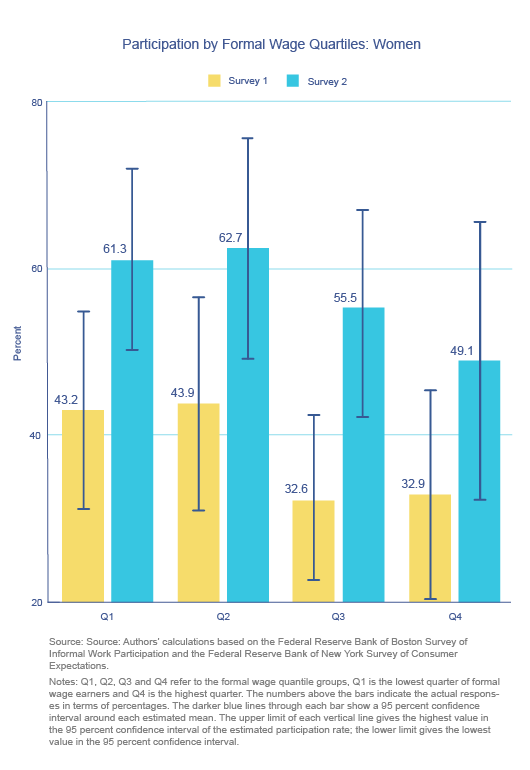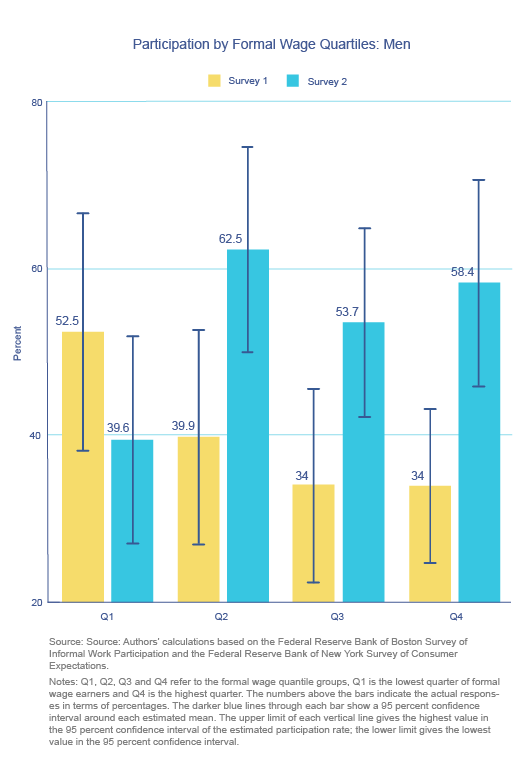2015 Series • No. 2015–10
Current Policy Perspectives
Changing Patterns in Informal Work Participation in the United States 2013–2015 
In light of the weak labor market conditions in the United States from 2008 until recently, one might have expected that participation in alternative income-generating activities, such as informal side-jobs, would have increased during that period. By the same logic, participation in informal work should have declined more recently, as conditions in the formal labor market improved. However, recent technological innovations have created a number of new opportunities for engaging in informal work. Such innovations may have promoted structural increases in informal work participation; if so we would expect informal work participation to remain elevated or increase further even as the economy improves.
To test these predictions the authors designed the Survey of Informal Work Participation, fielded within the Federal Reserve Bank of New York's Survey of Consumer Expectations. The survey was fielded in December 2013 and again in January 2015, on two separate, nationally representative samples. The first survey was designed mainly to assess the extent and intensity of participation in paid informal work activities and its determinants, the types of activities engaged in, and the extent to which such activities helped individuals to compensate for negative economic shocks during and after the recession. The second survey was designed to follow up on the main outcomes of the first and to determine whether the motivations for engaging in informal work and/or the types of people drawn to such work, had changed as the labor market improved

 Key Findings
Key Findings
- The participation rate in informal work increased significantly between the surveys, among both men and women. In the first survey, 40 percent of respondents (both sexes) participated in some type of informal paid activity (other than completing surveys). In the second survey, the share of survey takers who reported engaging in informal paid work increased to 52 percent among men and to 60 percent among women.
- In the first survey, men employed part-time were more likely to participate than those employed full -time, whereas employment status was not a significant factor in women's participation. Among both sexes, and controlling for employment status, individuals with higher formal wages were less likely to participate than those with lower formal wages, and informal work was driven mainly by the motivation to earn extra money. Informal work helped a significant share of those who engaged in it to offset negative effects of the recession.
- In the second survey, participation rates became more equal across education classes among both sexes. Among women, this equalization reflected in part a large increase in participation among those with high school or less, while among men, the equalization involved a large increase in participation by those with a graduate degree. Among men, participation rates became more equal across groups classified by employment status. As of the second survey, men from across the formal income distribution were roughly equally likely to participate in informal work, while the negative association between formal pay and informal participation remained in force among women.
- Female informal work participants in the second survey were more likely than those in the first to report that informal earnings were their main source of income and that informal work helped at least somewhat to offset recent negative employment shocks. This finding indicates that, despite the improved economy, informal work continues to serve as a kind of safety net for some individuals, and for women especially.

 Exhibits
Exhibits



 Implications
Implications
The authors hypothesize that the recent increases and improvements in the supply of informal work platforms help to account for the higher participation rate in the second survey, as well as for the finding that the set of informal workers appears more socioeconomically diverse in the second survey. Taken together, the results suggest the existence of two distinct groups-one with members who work informally to offset negative economic shocks, the other with members who work informally despite being already fairly well off. Supporting this idea, informal work participants with higher formal wages also tend to earn higher informal wages.



